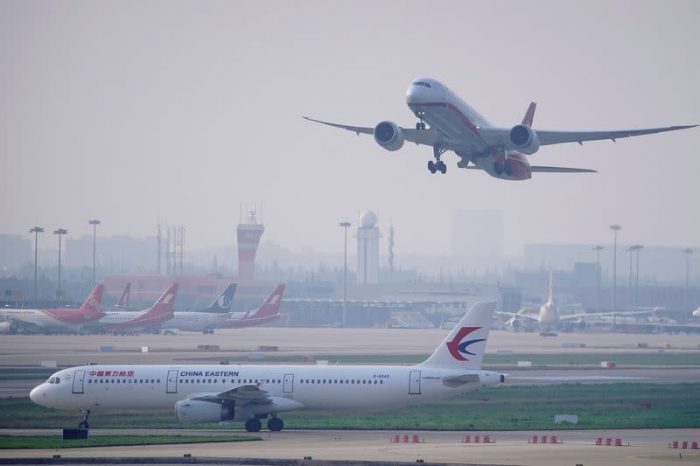China’s industrial output and retail sales slowed in April, while air freight capacity to the US has dropped by nearly a third, according to the latest data.
Data released by the National Bureau of Statistics on Monday showed factory output holding up slightly better than expected at 6.1% from a year earlier, but that was down from 7.7% growth in March.
Meanwhile, retail sales – a gauge of consumption – rose 5.1% in April, slowing from a 5.9% increase in March. Economists had expected retail sales to grow 5.5%, Reuters said.
ALSO SEE: TransPacific Cargo Surges on US-China Tariffs Backdown
Fixed asset investment expanded 4.0% in the first four months of 2025 from the same period a year earlier, compared with expectations for a 4.2% rise. It grew 4.2% in the first quarter.
Air cargo down on closure of loophole
Meanwhile, air freight capacity between China and the US was down significantly after a tax-free exemption for low-value parcels out of China was removed early this month, industry data showed, denting a significant revenue stream for Asia’s major airlines.
Air cargo carriers including Cathay Pacific, China Southern, Air China and Korean Air have profited from booming volumes of e-commerce, led by fast-fashion retailers such as Shein and PDD Holdings’ Temu, flowing from China to the United States.
A trade war detente on Monday between Washington and Beijing temporarily lowered reciprocal tariffs from more than 100%, prompting US firms to resume orders from China.
However, the “de minimis” duty-free access for low-value shipments from China and Hong Kong into the United States remains suspended and could weaken demand longer term, industry experts said.
Air cargo capacity is starting to recover since Monday’s agreement, said Marco Bloemen, managing director of air cargo consultancy Aevean. “But on the e-commerce side, though, volumes have been temporarily affected.”
The sudden drop in cargo demand for US shipments and dim prospects for a solid rebound create headwinds for airlines in Asia as they grapple with both a fall in passenger air fares and concerns over a global recession.
Cargo important for Cathay, Korean Air
Cargo makes up around a quarter of Cathay and Korean Air’s overall revenues. Cargo yields and revenues at a number of Asia’s airlines grew significantly faster than their passenger segments last year.
Last year low-value e-commerce shipments – at 1.2 million tonnes – made up 55% of goods shipped from China to the United States by air, compared to just 5% in 2018, an Aevean analysis showed.
Buoyed by strong air freight demand out of Asia since the pandemic, freight majors like Hong Kong-based Cathay, Singapore Airlines and Taiwan’s China Airlines all ordered large, new freighters for the busiest trade routes.
But with “de minimis” exemptions unlikely to return, the likes of Shein and Temu are increasingly looking to ship products in bulk via sea to the US or other warehousing locations instead of making individual shipments by plane direct to consumers.
Reuters reported on Thursday that fast fashion retailer Shein was leasing a huge warehouse in Vietnam in a move that could reduce its exposure to unpredictable US-China trade tensions.
Cathay, which operates from the world’s largest cargo airport, warned last month it was expecting air cargo demand between mainland China and the US to weaken from this month, as tariff hikes take hold. It did not immediately respond to a request for comment.
Air freight down 30% in recent weeks
Operators flew 26% less freight capacity from China and Hong Kong to the United States between the May 2 “de minimis” suspension and the May 13 detente compared with a year earlier, data from air cargo consultancy Rotate showed.
Capacity was down 30% compared with an average of the previous four weeks.
South Korea, a cargo hub that has benefited from the increasing volume of e-commerce out of China, saw a 22% fall in US-bound capacity between May 2 and 13.
Korean Air said in mid-April it expected volatility in air freight demand to intensify as tariffs were imposed.
The falls reverse a trend of capacity being on average 15% higher than the year prior during the preceding 12 months from China, and 14% higher from South Korea.
US-headquartered Atlas Air, which operates the most capacity on the Greater China to US route, saw a 28% fall in capacity from May 2 to 13 from a year prior, Rotate data showed.
Cathay Pacific saw a 2% drop, and Chinese state-owned China Southern’s capacity fell 30%.
For airlines with freighter aircraft, cargo was a lifeline during the pandemic when nearly all international passenger flights were grounded.
Several Asia-Pacific airlines said in financial reports covering the period before the tariffs took effect they would seek to move capacity to other routes to deal with fluctuating demand.
Asia-focused freight forwarder Dimerco this month said several scheduled freighter services were cancelled on the China-US corridor, with some capacity rerouted to Mexico and Latin America.
Roughly 70 freighters stopped flying for a while on the TransPacific routes, but some were deployed in other markets, Bloemen said.
Countries in Southeast Asia stand to gain should manufacturers choose to make or ship goods to the United States from countries other than China – although many of those countries also face new tariffs.
- Reuters with additional editing by Jim Pollard
ALSO SEE:
US Tariff Pause Puts Heat on China+1 Trade Via SE Asia, Mexico
Asian Markets Rise After US, China Agree to Cut Majority of Tariffs
Fear of Huge Job Losses Led to China’s Move to Discuss Tariffs
China Unveils Propaganda Video, Vows to ‘Never Kneel’ to Bullies
China Lifts Tariff on US Goods to 125%, as ‘Hikes Become a Joke’
World Faces ‘Significant Slowdown’ From US Tariffs, IMF Says
US Postal Service Suspends Receipt of Parcels From China, HK
Shein, Temu, Amazon Haul Seen Raising Prices as Loophole Shut
Trump Seen Blocking the ‘De Minimis’ Trade Loophole With China
US to Curb Cheap China Parcels: Temu, Shein Face Big Hit
US Lawsuit Says Temu Shopping App Has ‘Hidden Spyware’ – AT























